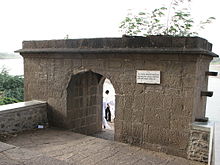Sambhaji
Sambhaji Bhosale or Chhatrapati Sambhaji Raje Bhosale (* May 14, 1657 in Purandar -Fort, † March 11, 1689 in Tulapur ) was the eldest son of Shivaji (around 1630-1680), the leader of the Marathas . In addition to his father, many Indians consider him a Hindu fighter against the overwhelming power of the Muslim Mughal Mughal Aurangzeb and a pioneer for India's independence.
biography
Sambhaji was born in Purandar Fort about 50 km southwest of the city of Pune . His mother was Saibai, who died two years after he was born. At the age of 9 he was sent as a political hostage to Jai Singh I at the Rajput court of Amber to ensure compliance with the "Treaty of Purandar" concluded between the Mughal empire and the Marathas in 1665. The provisions of the treaty also included the passage that both Shivaji and his son Sambhaji had to provide military aid to the Mughal ruler Aurangzeb. In May 1666 they both presented themselves at the Mughal court, but after a dispute they were placed under arrest, from which they were able to escape in July.
Sambhaji married the daughter of a local ruler in Shivaji's service. A few years later (1678) he was arrested by his father for “irresponsible behavior and sensual pleasures”; he escaped to the Mughal court with his wife. After his return in 1679, his father had him arrested again and locked up in the Panhala Fort. Shivaji died the following year while his son was still in prison; his wife Soyarabai, Sambhaji's stepmother, successfully enthroned her own son Rajaram .
Thereupon Sambhaji fled again, seized several fortresses and was formally confirmed as the leader of the Marathas in July 1680. He managed to capture his stepmother and stepbrother; Soyarabai was executed for conspiracy in October 1680.
In the following year, Sambhaji's troops captured the Mughal city of Burhanpur in the absence of the local commander and massacred the Muslim soldiers and the population. The city and its important river port were also set on fire. This led to a conflict with the Mughal Empire that lasted for several years, which Sambhaji evaded by initiating - ultimately unsuccessful - sieges of the fortress on the island of Janjira, about 100 km south of Bombay, and the Portuguese colony of Goa . Both times he was driven away by the arrival of Mughal troops.
In the years 1681 to 1685 he also turned to the prosperous city of Mysore , which, however, resisted and signed a treaty. After further raids and raids, he was captured by the Mughal troops in 1689 and brought before the Mughal ruler Aurangzeb, who was staying in Bahadurgad and who had him and his companions dressed in clown costumes. Because of the killing of Muslims, the atrocities involved in taking Burhanpur and his refusal to convert to Islam, the Mughal Great Mogul beheaded him at Tulapur . Allegedly his body was thrown for the dogs to eat.
His younger stepbrother Rajaram (see Tara Bai ) became Sambhaji's successor.
Honors
After India gained independence, many monuments were erected in honor of Sambhaji, especially in the Indian state of Maharashtra ; these can easily be confused with those of his father.
literature
- Kamal Shrikrishna Gokhale: Chhatrapati Sambhaji. Navakamal Publications, Pune 1978.
- Stewart Gordon: The Marathas 1600-1818. Cambridge University Press 1993, ISBN 978-0-521-26883-7 .
- YG Bhave: From the Death of Shivaji to the Death of Aurangzeb. The Critical Years. Northern Book Center 2000, ISBN 978-81-7211-100-7 .
Web links
| personal data | |
|---|---|
| SURNAME | Sambhaji |
| BRIEF DESCRIPTION | Leader of the Marathas |
| DATE OF BIRTH | May 14, 1657 |
| PLACE OF BIRTH | Purandar- Fort |
| DATE OF DEATH | March 11, 1689 |
| Place of death | Tulapur |

